Contents
Market Overview
Macro Review
An outsized hike from the ECB may not be a “one-off”. The ECB raised rates by 75bp and signalled that they could hike by that factor again in October. However, the Central Bank’s forecasts for the eurozone were more troublesome. The ECB sees 2022 inflation at 8.1% (raised from 6.8%), with inflation topping 5.5% next year (up from 3.5%) and at 2.3% in 2024, implying that it will remain above target until 2025 at the earliest. The growth outlook is similarly dire but they held back from forecasting a recession like the Bank of England did. The ECB are forecasting GDP to settle at 0.9% in 2023 from 2.1% previously. Markets are also becoming accustomed to “Trussonomics” in the UK, just as they familiarize with the protocol ahead of King Charles III reign. The UK will enter ten-days of mourning, with a public holiday on the day of Queen Elizabeth II funeral, when the London Stock Exchange, banks and UK gilts market will close. This also means the Bank of England interest rate decision will be postponed to September 22 (the day after the FOMC). The volatility in gilts on the back of outsized fiscal initiatives caused government bonds to widen +10-28bp, where bunds reacted to the ECB decision and widened +12-25bp. U.S. Treasuries were +8-10bp wider on the week given Powell’s comments and hawkish Fedspeak. For many emerging markets, the downside surprises in inflation were somewhat unconvincing this week, aside from the softness out of Brazil and China. Hungary’s monthly inflation showed signs of slowing, but headline inflation is already at 15.6%. Then Mexico’s inflation print surprised to the upside (8.7%), just as Chile’s came in at 14.1%, which could be why the Chilean Central Bank reacted steadfastly with a 100bp hike (consensus was 75bp). Poland is another good example of a Central Bank that dovishly hiked rated by 25bp in the face of headline inflation of 16.1%. However, a decline in Eurozone headline inflation could soon come with further EU measures aimed at capping gas prices, following the G7 Russian oil price cap introduced last week.
EM Credit Update
Emerging market sovereign credit ended the week up 0.2% with spreads 12bp tighter, which takes the EMBI below 500bp in spread. Outperformers over the week were Ghana, Kenya and Argentina while Zambia, Sri Lanka and Pakistan underperformed. The market also showed some signs of life with the triple-tranche new issue from Indonesia that garnered an order-book of $10bn for an issue size of $2.65bn. The appetite for 5-year and 10-year risk seemed more limited, while the 30-year tranche traded rather well.
The Week Ahead
Key events include U.S. inflation and the slew of Chinese data next week. China’s industrial production is expected to strengthen, along with retail sales and fixed asset investments, but the 1-year MLF rate ought to remain unchanged in spite of CNH/CNY weakness. The calendar across EM inflation is also full with releases out of Argentina, Czech Republic, Israel, India, Poland and Romania. Russia is the only major EM with an interest rate decision (8.0%), although geopolitics is likely to overshadow this. In President Xi Jinping’s first foreign trip in two years, he will be meeting with Vladimir Putin in Uzbekistan. Finally, Turkey will publish its current account balance, which is expected to widen and will offer further insight into how steep the net errors and omissions figures are becoming.
Highlights from emerging markets discussed below include: The rejection of a new constitution in Chile, China cuts reserve requirements and economic conditions in South Africa.
Fixed Income
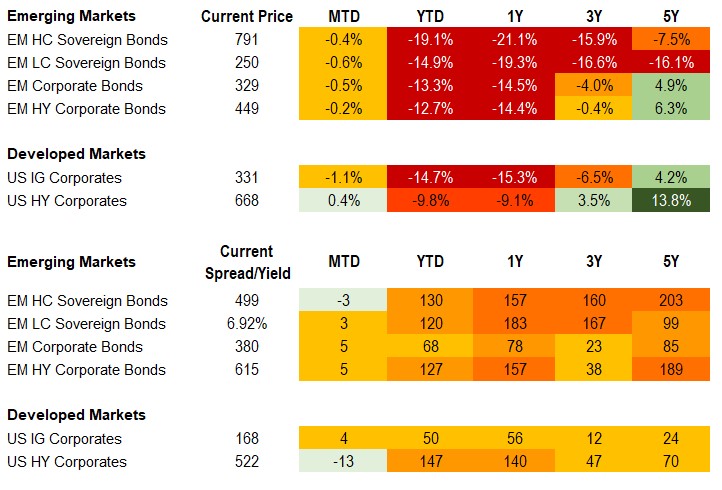
Equities
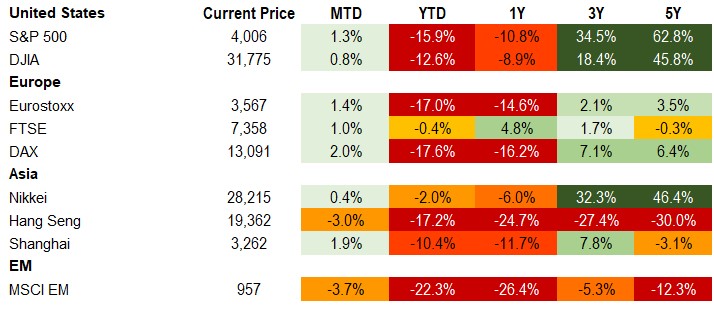
Commodities

Source for data tables: Bloomberg, JPMorgan, Gramercy. EM Fixed Income is represented by the following JPMorgan Indicies: EMBI Global, GBI-EM Global Diversified, CEMBI Broad Diversified and CEMBI Broad High Yield. DM Fixed Income is represented by the JPMorgan JULI Total Return Index and Domestic High Yield Index. Fixed Income, Equity and Commodity data is as of September 9, 2022 (mid-afternoon).
Emerging Markets Weekly Highlights
А resounding rejection of Chile’s new constitution weakens the Administration, but also signals a likely policy shift to the center
Event: On Sunday, Chileans voted in a referendum on a new constitution, rejecting the proposed draft by a resounding 62% vs 38%, a much larger margin than predicted by the polls.
Gramercy commentary: The result and the large margin for “reject” represent a significant political defeat for leftist President, Gabriel Boric who has thrown his full support behind the new constitution. This will likely further weaken his Administration’s ability to implement policy just six months into their term and does not bode well for the prospects of important economic reforms going forward. At the same time, tangible signals have already emerged that in the wake of the defeat, Boric intends to steer his government in a more centrist direction. A shift would be welcomed by markets given the rejected constitutional draft was perceived as too “radical” and a structural departure from the conservative social, economic and political framework traditionally associated with Chile. As a first step toward moderation, Boric reshuffled his cabinet, appointing new Ministers of Interior, Health, Science and Energy with center-left rather than far-left backgrounds. As such, the center of gravity in the Boric Administration seems likely to shift toward market-friendly figures such as Finance Minister, Mario Marcel, for example, which we see as credit-positive. We expect these trends to support credit spreads, especially for corporate issuers in sectors that would have been heavily impacted by the now rejected constitution proposal. This being said, from macro and sovereign perspectives, global headwinds remain significant, which, in combination with still elevated domestic political noise, is likely to prevent a major recovery in Chilean assets in the near-term, in our view.
China cut RRR for FX deposits to improve foreign liquidity while August trade data softened
Event: The People’s Bank of China lowered the reserve requirement for FX deposits by 200bps to 6% over the weekend in the backdrop of CNY depreciation, freeing-up just under $20bn of FX liquidity. Meanwhile, August trade data moderated relative to recent months with export growth of 7.1% y/y vs. 18% y/y in July on a partial retrace of the post-lockdown recovery and softer global demand. Import growth also eased to 0.3% y/y from 2.3% y/y as domestic consumption remained constrained.
Gramercy commentary: We see some room for additional FX pressure on the spot rate, although we think authorities will aim to keep it from significantly breaching 7.0 yuan per dollar and target stability heading into the Party Congress next month. While exports will likely face further pressure as global demand wanes and zero-COVID largely remains intact, the current account should remain in surplus given travel restrictions and associated import softness. Analysts have continued to lower 2022 growth forecasts with the consensus now around 3.5%. Barclays notably lowered their estimate to 2.6% this week. While the recovery continues to ebb and flow, the credit impulse has moved back into positive territory indicating some room for incremental improvement with any larger scale upside dependent on COVID and property sector policy.
South Africa soft 2Q GDP and current account prints weigh on rand
Event: Second quarter growth contracted 0.7% q/q from 1.9% q/q in 1Q and eased to 0.2% y/y from 3.0% y/y in 1Q. The weakness was in part driven by supply side dynamics from flooding, electricity cuts, and industrial action as well as a drag from net trade amid elevated imports on the demand side. Similarly, the current account swung into deficit of 1.3% of GDP in 2Q from surplus of 2.2% of GDP in 1Q on trade balance deterioration as well as widening of non-trade accounts due to outgoing dividend payments likely linked to repatriation of windfall mining sector profits.
Gramercy commentary: While overall slowing growth challenges the South African Reserve Bank policy, the strong domestic demand component of the 2Q growth print as well as recent currency pressures in the wake of political noise and reversal in external accounts should keep the Central Bank hawkish and conservative in the near-term. We think the current account will likely post a smaller than originally expected surplus for the year, comfortably below current market consensus of 1.7% of GDP. While the rand has likely moved into cheap or undervalued territory, the currency remains subject to volatility in the current context of weaker global growth, softening commodity prices and political headline risk as the National Executive Committee of the African National Congress nears.
Emerging Markets Technicals
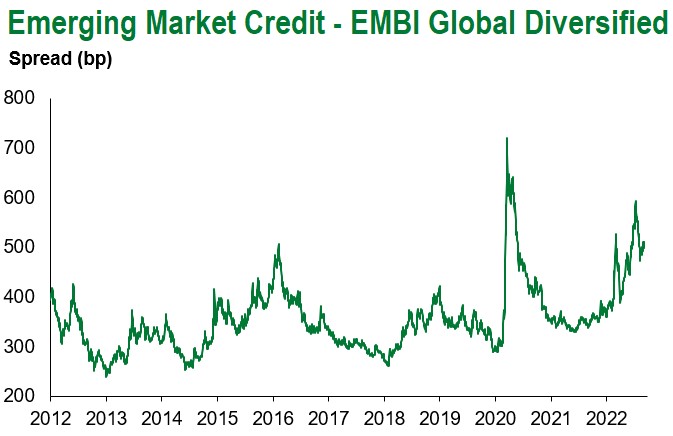
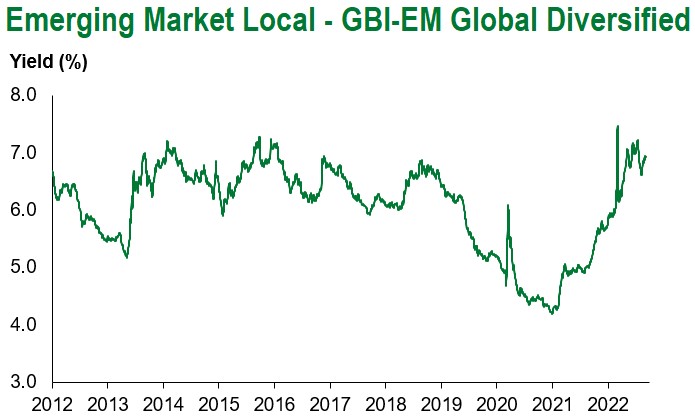
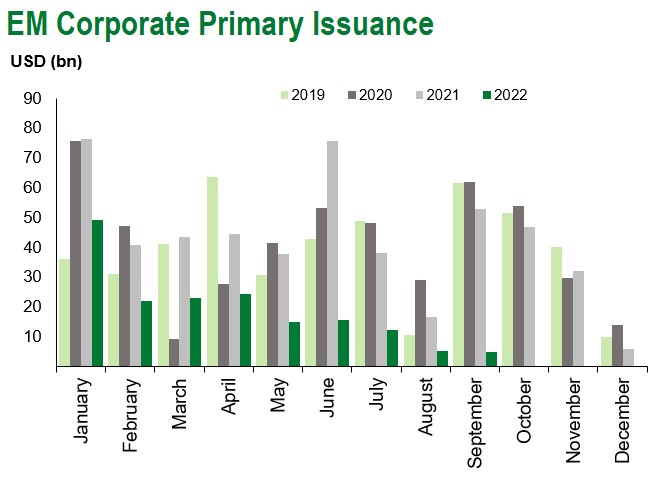
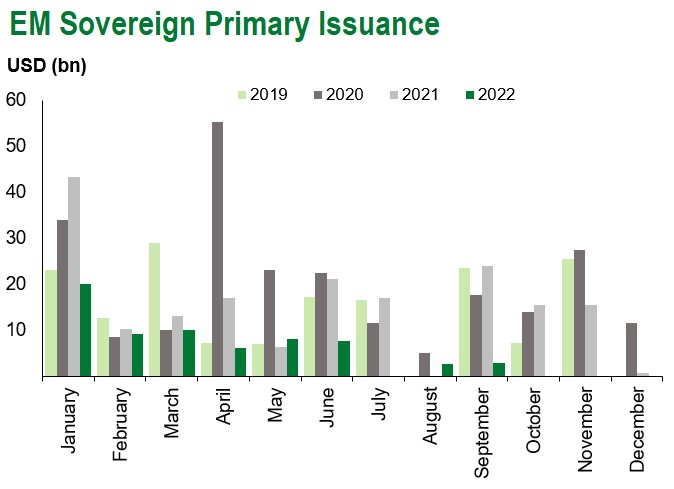
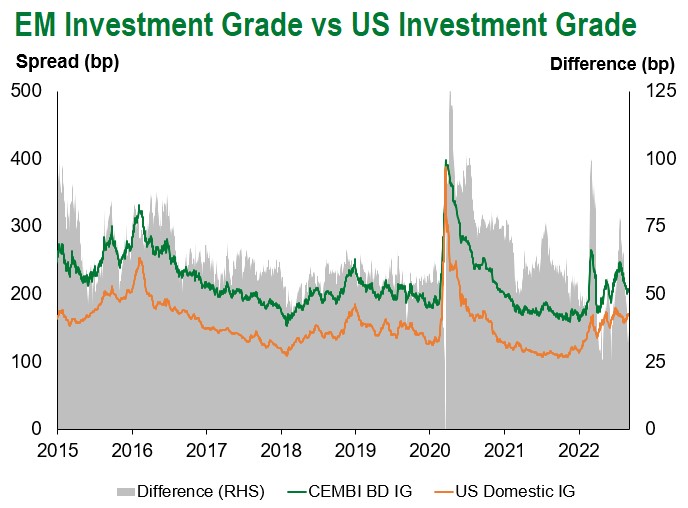
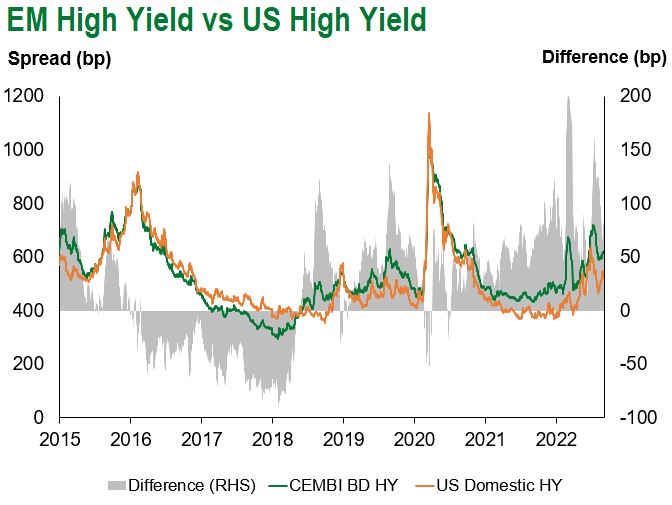
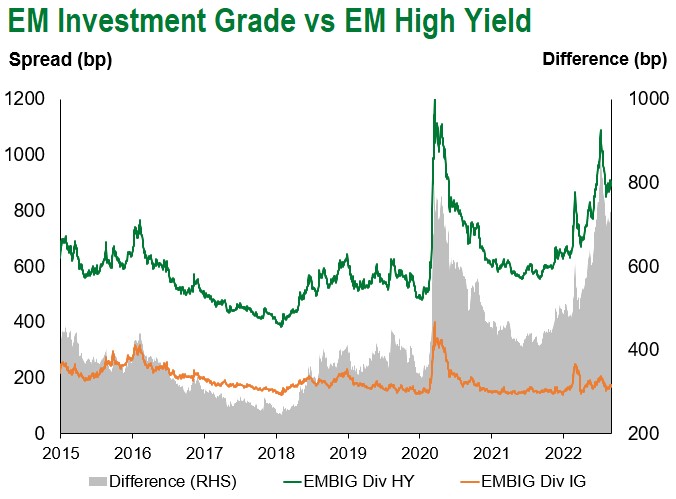
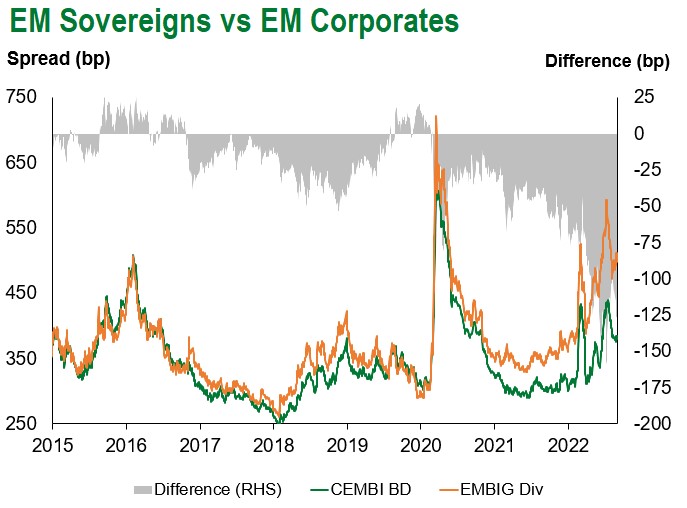
Emerging Markets Flows
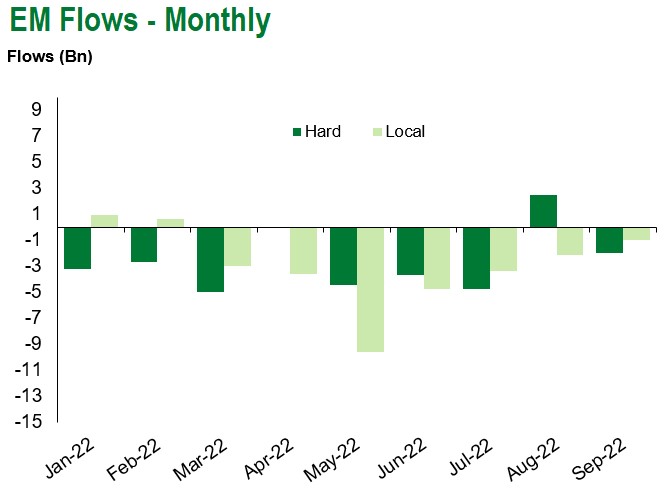
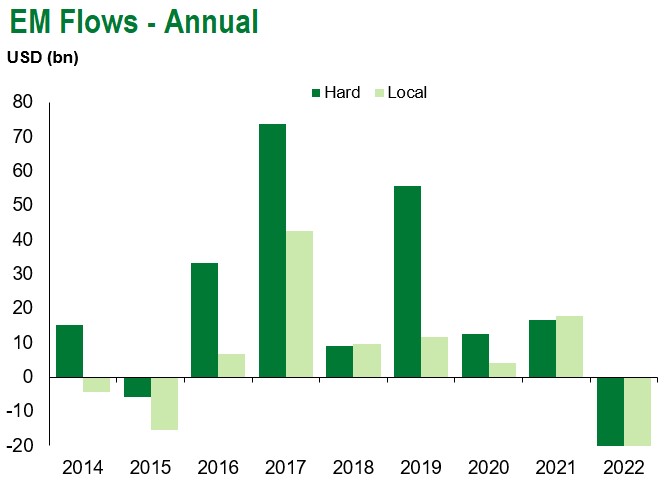
Source for graphs: Bloomberg, JPMorgan, Gramercy. As of September 9, 2022.
COVID Resources:
Johns Hopkins COVID-19 Case Tracker
For questions, please contact:
Kathryn Exum, CFA ESG, Director, Co-Head of Sovereign Research, [email protected]
Petar Atanasov, Director, Co-Head of Sovereign Research, [email protected]
James Barry, Director, Deputy Portfolio Manager, [email protected]
This document is for informational purposes only. The information presented is not intended to be relied upon as a forecast, research or investment advice, and is not a recommendation, offer or solicitation to buy or sell any securities or to adopt any investment strategy. Gramercy may have current investment positions in the securities or sovereigns mentioned above. The information and opinions contained in this paper are as of the date of initial publication, derived from proprietary and nonproprietary sources deemed by Gramercy to be reliable, are not necessarily all-inclusive and are not guaranteed as to accuracy. This paper may contain “forward-looking” information that is not purely historical in nature. Such information may include, among other things, projections and forecasts. There is no guarantee that any forecasts made will come to pass. Reliance upon information in this paper is at the sole discretion of the reader. You should not rely on this presentation as the basis upon which to make an investment decision. Investment involves risk. There can be no assurance that investment objectives will be achieved. Investors must be prepared to bear the risk of a total loss of their investment. These risks are often heightened for investments in emerging/developing markets or smaller capital markets. International investing involves risks, including risks related to foreign currency, limited liquidity, less government regulation, and the possibility of substantial volatility due to adverse political, economic or other developments. References to any indices are for informational and general comparative purposes only. The performance data of various indices mentioned in this update are updated and released on a periodic basis before finalization. The performance data of various indices presented herein was current as of the date of the presentation. Please refer to data returns of the separate indices if you desire additional or updated information. Indices are unmanaged, and their performance results do not reflect the impact of fees, expenses, or taxes that may be incurred through an investment with Gramercy. Returns for indices assume dividend reinvestment. An investment cannot be made directly in an index. Accordingly, comparing results shown to those of such indices may be of limited use. The information provided herein is neither tax nor legal advice. Investors should speak to their tax professional for specific information regarding their tax situation.
